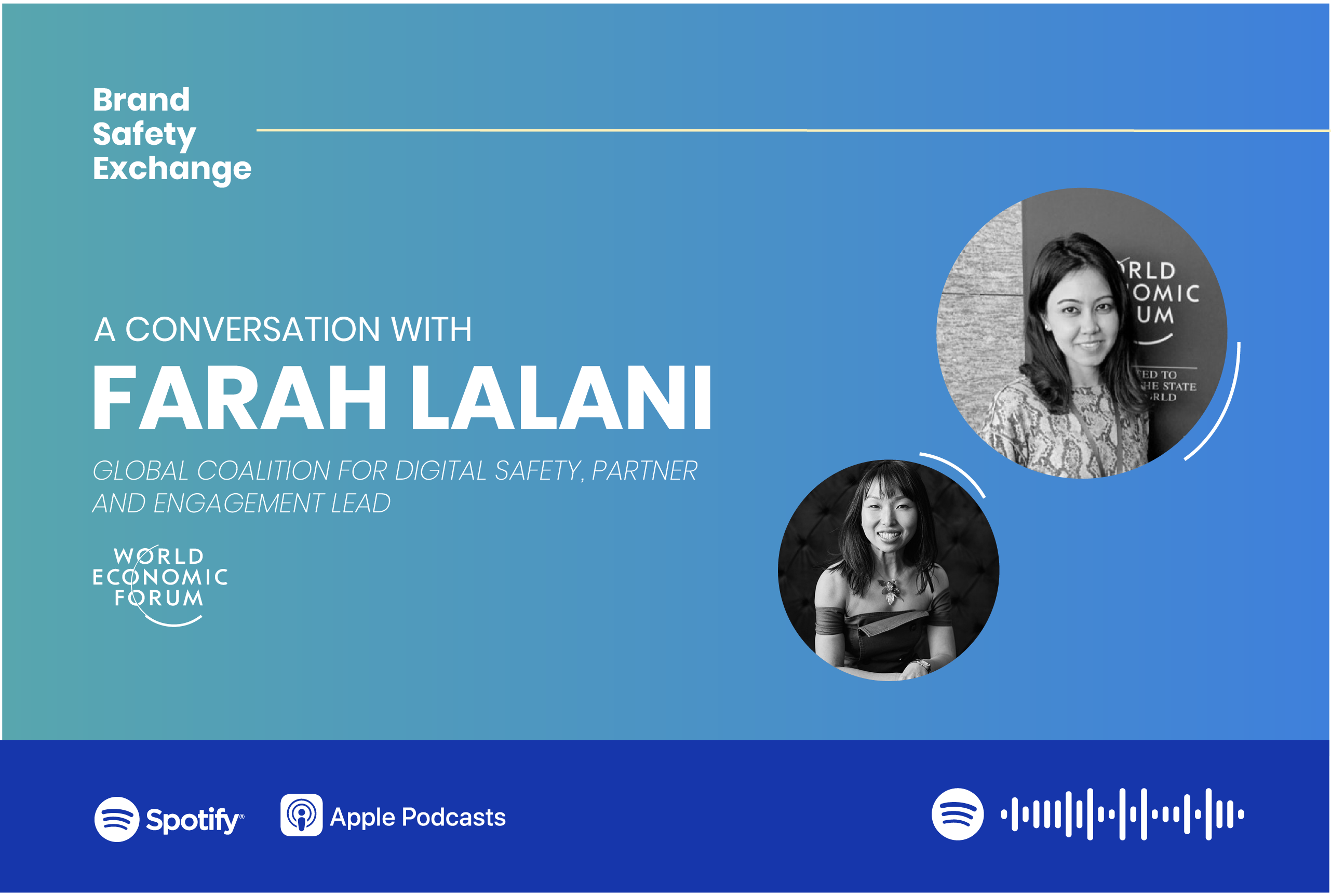Effectively addressing the numerous nuances and intricacies that exist when it comes to safer online platforms, and indeed a safer internet as a whole requires employing a multiperspective approach.
In this third episode of the Brand Safety Exchange our host, Tiffany Xingyu Wang introduces us to Farah Lalani, the Lead for the World Economic Forum’s pioneering Global Digital Safety Coalition. As a leader who is passionate about creating a safer and more trustworthy internet, Farah is optimally positioned to work alongside some of the world’s most notable media and technology companies, governments, academia and civil societies to facilitate the necessary multistakeholder meeting of minds for the task at hand.
Multiple Minds to Advance Balancing Safety, Privacy & Free Expression
Farah emphasises that while advancements in technology have given us the privilege, and creating and distributing content far more easily, these very same features have brought about one of the greatest challenges too, namely, the creation of harmful content and conduct online. Some of the more recent examples include how misinformation around the COVID-19 vaccine and child sexual abuse, for instance, have skyrocketed.
This alarming trend was the tipping point in forming the Coalition. While exceptional initiatives are hard at work concerning regulation and safety, Farah references the noticeable gap in having a trusted forum to advance cooperation between the public and private sectors on core matters. One of these concerning issues specifically is balancing safety, privacy and free expression whilst being able to govern the trade-offs that exist. The agenda of the Coalition is ambitious yet clear
At the very core of the Coalition lies the need to resolve core topics that, according to the Coalition, are hindering progress in improving digital safety. The overarching goals are geared towards developing global principles for digital safety and developing digital tool kits that guide how to use key interventions when required.
Steering the conversation to the heart of the issues at hand, Farah highlights that there is perceptible pragmatic use of the Coalition to expedite digital safety advancements. The Coalition is being primed to facilitate and exchange best practices when it comes to new online safety regulations, reduce the risk of harm online and improve digital media literacy.
The multi-stakeholder collaboration incorporates thought-leaders from the media and technology sectors, academia, governments, civil society and the private business sectors. Amongst the many stakeholders are Belgium, Australia, the UK and USA, Microsoft, Spectrum Labs, Stanford University, Oxford, UNICEF and more. Farah drives home the significance of this undertaking in creating a more streamlined strategy for digital safety across sectors and territories.
Aligning on Fundamentals and Approach Rather than Regulation
The conversation scrutinises how in this worldwide digital society while aligning with a myriad of rules and regulations may be possible for large companies, and how it could potentially deter the next large media platform from actually materialising because of the mammoth task of trying to align with every rule and regulation that exists. A multi-stakeholder approach would give consumers more choice as it fosters a more competitive and innovative media ecosystem. Similarly, it would define a more streamlined campaign to establish a minimum bar for online trust and safety. While ambitious, the endeavour by the Coalition is not so much centred on having everyone adopt the same policies, but rather, aligning on certain fundamentals.
The conversation between Tiffany and Farah circles back to the example of child safety. While companies insist that their products may not be used under a certain age, children find a way to circumvent this by simply inputting a relevant date of birth. Farah concludes that a certain fundamental in this instance could be a more robust age verification solution that would accommodate different age policies across various countries. In other words, it is more the approach that should be standardised.
Privacy, Understanding Technology, Awareness and Governance
In short, the Coalition purports that despite the multiple views on enforcement, finding regulation that aligns business incentives, safety and the public interest is beneficial. The solution lies in confronting and navigating the complexities of the intersection of privacy, the understanding of tech, awareness and governance.
Leading the Global Coalition for Digital Safety has prompted Farah and her team to embrace the role of the startup ecosystem even more because of how they tackle online toxicities through their innovations. Ultimately, the success of the Coalition would be measured by:
- Producing a global view of digital safety principles that governments and multiple companies rally behind.
- The optimal adoption of interventions to create the safest platforms available.
Key Lessons to Amplify Brand Safety
- Consumers are more empowered and able to exercise more control of their safety if a more competitive media ecosystem exists.
- Countries and brands need to tackle how illegal content is eliminated.
- Trust and safety are rooted in good content, more users as a result and more revenue which can become the backbone of the greater economy.
- When it comes to encryption, ask if is society willing for predators to take advantage of children’s images and remain unscrutinised?
- Ask whose privacy is being protected in each case?
- Ask what we’re willing to forego while examining what we stand to gain when it comes to privacy and encryption.
Watch the full interview below or listen and subscribe to the Brand Safety Exchange podcast on Apple Podcasts and Spotify.




